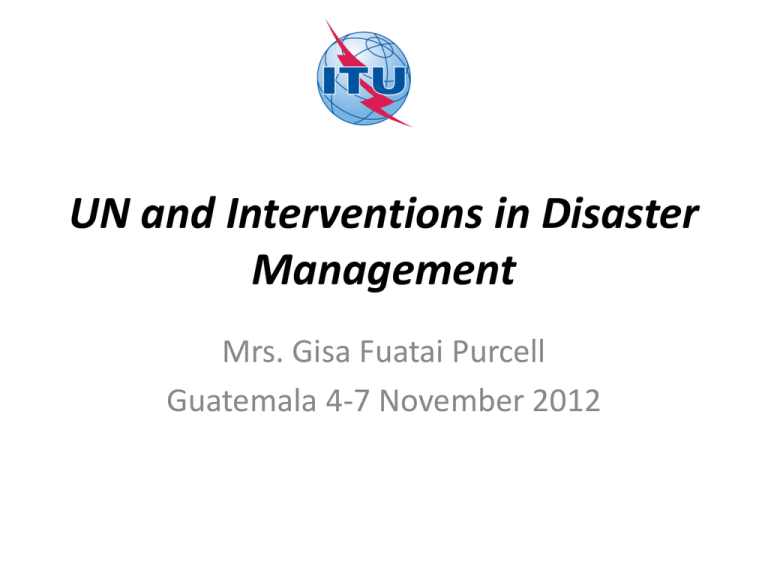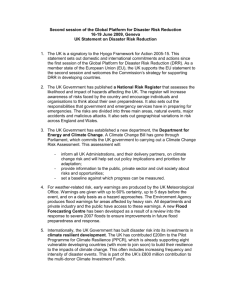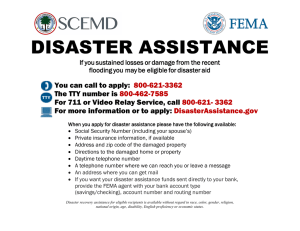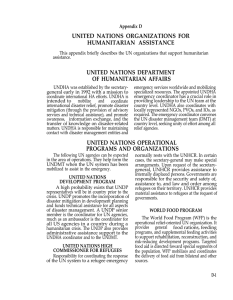UN and Interventions in Disaster Management Mrs. Gisa Fuatai Purcell
advertisement

UN and Interventions in Disaster Management Mrs. Gisa Fuatai Purcell Guatemala 4-7 November 2012 Lead UN Organizations • • • • • • • • • • FAO ILO ITU OCHA UNDP / BCPR UNEP UNESCO UNFCCC UNFPA UN-HABITAT • • • • • • • • • • UNICEF UNITAR UN-OHRLLS UNOOSA UNU UNV WFP WHO WMO WORLD BANK FAO The Food and Agriculture Organization of the United Nations The Food and Agriculture Organization of the United Nations General description of the organization • FAO leads international efforts to defeat hunger. Core areas of FAO’s mandate are to improve agricultural productivity, to raise levels of nutrition, better the lives of rural populations and contribute to the growth of the world economy. ILO International Labour Organization • The International Labour Organization (ILO) is the United Nations agency devoted to advancing opportunities for women and men to obtain decent and productive work in conditions of freedom, equity, security and human dignity. • ILO is the only ‘tripartite’ UN agency in that it brings together governments and representative organizations of employers and workers to jointly shape labour policies and to negotiate agreements by consensus. ILO International Labour Organization Goals • In disaster scenarios, ILO – in partnership with other UN and multilateral agencies contributes to enhance disaster recovery and risk reduction efforts focusing on employment creation, income generation, disaster risk reduction of vulnerable livelihoods and the promotion of sustainable local development. ITU International Telecommunication Union • ITU is the leading United Nations agency for information and communication technologies. ITU helps governments and the private sector in three core sectors: radiocommunication, standardization and development. ITU also organizes TELECOM events and was the lead organizing agency of the World Summit on the Information Society. • ITU is based in Geneva, Switzerland, and its membership includes 193 Member States and more than 700 Sector Members and Associates. OCHA United Nations Office for the Coordination of Humanitarian Affairs • OCHA’s mission is to mobilise and coordinate effective and principled humanitarian action in partnership with national and international actors in order to alleviate human suffering in disasters and emergencies, advocate for the rights of people in need, promote preparedness and prevention and facilitate sustainable solutions. OCHA United Nations Office for the Coordination of Humanitarian Affairs Goals of DM • OCHA’s objective is greater incorporation of disaster risk reduction approaches into humanitarian work and strengthened preparedness for effective humanitarian response. • OCHA is lead by the Under-Secretary-General for Humanitarian Affairs and Emergency Relief Coordinator, who is also the Chair of the ISDR system as well as the Chair of the Inter-Agency Standing Committee. UNDP – Bureau for Crisis Prevention and Recovery • UNDP is the UN’s global development network, an organization advocating for change and connecting countries to knowledge, experience and resources to help people build a better life. UNDP works on the ground in 166 countries, working with countries on their own solutions to global and national development challenges. UNDP Bureau for Crisis Prevention and Recovery Goals in DRR and DM • UNDP supports disaster-prone countries in the development of legislative frameworks, operational systems and coordination mechanisms to ensure the integration of risk reduction into human development, through its Bureau for Crisis Prevention and Recovery. UNEP The United Nations Environment Programme • The United Nations Environment Programme (UNEP) is the environmental agency of the United Nations. As such, it has the mandate to both drive the integration of environmental and sustainable principles into the activities of the UN family, and deliver its own specialist programmes on environment, sustainable development, and conflicts and disaster management. UNEP The United Nations Environment Programme Goals in DRR and DM • enhanced capacity of Member States in environmental management in order to contribute to natural and man-made disaster risk reduction; • upon request by Member States to provide early warning on environmental risks, environmental data and expertise on sustainable management of transboundary and shared natural resources; • to contribute to global policy development by mainstreaming environmental lessons learned and best practice into the relevant policy and planning processes; • to conduct rapid and reliable post-crisis assessments following conflicts and disasters as requested; • to contribute to improved environmental management and the sustainable use of natural resources through post-crisis assessment and recovery process. UNESCO United Nations Educational, Scientific and Cultural Organization • UNESCO is the United Nations’ specialized agency for education, science and culture. Since its creation in 1945, the Organization has worked to promote knowledge and education worldwide. Its close links with professional and academic communities and other partners in 193 countries put it in a key position to press for action. UNESCO United Nations Educational, Scientific and Cultural Organization Goals in DRR and DM • UNESCO assists Member States in building capacities to withstand and cope with natural events and human induced disasters, including those of a technological nature. UNESCO seeks to harness knowledge and technology and promote education for building effective capacities to foster prevention and reduce vulnerability to all kinds of disasters, particularly affecting poor populations. UNFCCC SECRETARIAT The United Nations Framework Convention on Climate Change Secretariat • In 1992, most countries joined an international treaty -- the United Nations Framework Convention on Climate Change (UNFCCC) -- to begin to consider what can be done to reduce global warming and to cope with whatever temperature increases are inevitable. More recently, a number of nations approved an addition to the treaty: the Kyoto Protocol, which has legally binding measures and entered into force on 16 February 2005. UNFCCC SECRETARIAT The United Nations Framework Convention on Climate Change Secretariat Goals in DM • Decision 1/CP.13, or the Bali Action Plan, highlights the significance of disaster risk reduction and risk management as part of enhanced action on climate change adaptation. UNFPA United Nations Population Fund • UNFPA is an international development agency that promotes the right of every woman, man and child to enjoy a life of health and equal opportunity. UNFPA supports countries in using population data for policies and programmes to reduce poverty and to ensure that every pregnancy is wanted, every birth is safe, every young person is free of HIV/AIDS, and every girl and woman is treated with dignity and respect. UNFPA United Nations Population Fund Goals in DM • To ensure adequate emergency preparedness and contingency planning at country level and to improve environmental protection. UN-HABITAT United Nations Human Settlements Programme • UN-HABITAT is the United Nations agency for human settlements. It is mandated by the UN General Assembly to promote socially and environmentally sustainable towns and cities with the goal of providing adequate shelter for all. UN-HABITAT is one of the few international institutions that provides an overall perspective on urbanisation processes and the only one with housing and urban development as its principal mandate. UN-HABITAT United Nations Human Settlements Programme Goals in DM • Increasing investment in disaster risk reduction - redirecting priorities • from visible and short-term development projects to abstract long term • potential threats and risks. • Addressing the root causes of disasters - inadequate development • practices increase the vulnerability of communities, and more focus on pre-disaster risk reduction needs to be integrated in all development planning. • Incorporating vulnerability reduction and disaster management into on- going national and local development and poverty reduction plans. • Redirecting the focus on disaster risk reduction and mitigation rather than preparedness and response related strategies in the human settlements context. • Building a culture of prevention entails a cross sectoral, multi-dimensional approach integrating participatory analysis of risk, implementation of programmes, and development of policy and legal frameworks with all stakeholders including civil society, private sector, local, national and international government, in a gendered and comprehensive process. UNICEF United Nations Children’s Fund • UNICEF is mandated by the United Nations General Assembly to advocate for the protection of children’s rights, to help meet their basic needs and to expand their opportunities to reach their full potential. • UNICEF is guided by the Convention on the Rights of the Child and the Convention on the Elimination of All Forms of Discrimination Against Women and strives to establish girls and boys rights as enduring ethical principles and international standards of behavior towards children. UNICEF United Nations Children’s Fund Goals in DRR and DM • To meet the objectives of the HFA, UNICEF believes it is critical that develop- ment work is ‘hazard proofed’, that education facilities are safe and provide an opportunity for children and adults to learn about disasters and that humanitarian action and recovery contribute to a reduction of disaster risk. UNICEF also supports early warning and emergency preparedness facilitat- ing a timely, effective and national authority led humanitarian response. UNITAR United Nations Institute for Training and Research • The United Nations Institute for Training and Research (UNITAR) is making concrete contributions to developing the capacities of tens of thousands of people around the world. Since its inception in 1965, UNITAR has built sustainable partnerships acquiring unique expertise and accumulating experience and knowledge to fulfill its mandate.These accomplishments have enabled UNITAR to respond to the growing demand from UN Member States for training for capacity development in the fields of Environment; Peace, Security and Diplomacy; and Governance. UNITAR United Nations Institute for Training and Research Goals in DRR and DM • Develop capacities of Member States and their local authorities to reduce disaster risks. UN-OHRLLS Office of the High Representative for the Least Developed Countries, Landlocked Developing Countries and Small Island Developing States • • UN-OHRLLS, established by the United Nations General Assembly in 2001, advocates for the least developed countries (LDCs), landlocked developing countries (LLDCs) and small island developing States (SIDS). UN-OHRLLS coordinates and mobilizes international support and resources for the implementation of the Brussels Programme of Action for the Least Developed Countries 2001-2010, adopted by the Third United Nations Conference on the Least Developed Countries in Brussels in 2001; Almaty Declaration and Programme of Action for Transit Transport Cooperation between Landlocked and Transit Developing Countries; and the Mauritius Strategy, for the further implementation of the Barbados Programme of Action for the Sustainable Development of Small Island Developing States, adopted in Mauritius in 2005. It also supports the Economic and Social Council as well as the General Assembly regarding the Brussels Programme. UN-OHRLLS Office of the High Representative for the Least Developed Countries, Landlocked Developing Countries and Small Island Developing States Goals in DRR and DM • To strengthen disaster mitigation and preparedness and to promote the sustainable development of the LDCs, LLDCs and SIDS. UNOOSA United Nations Office for Outer Space Affairs • The United Nations Office for Outer Space Affairs (UNOOSA) implements the decisions of the General Assembly and of the Committee on the Peaceful Uses of Outer Space and its two Subcommittees, the Scientific and Technical Subcommittee and the Legal Subcommittee. The Office is responsible for promoting international cooperation in the peaceful uses of outer space, and assisting developing countries in using space science and technology. UNOOSA United Nations Office for Outer Space Affairs Goals in DRR and DM • Ensure that all countries and international and regional organizations have access to and develop the capacity to use all types of spacebased information and solutions to support the full disaster management cycle. UNU United Nations University • United Nations University (UNU) is an autonomous organ of the UN General Assembly dedicated to generating and transferring knowledge and strengthening capacities relevant to global issues of human security, development, and welfare. UNU is ‘an international community of scholars, engaged in research, post-graduate training and dissemination of knowledge’ to provide fresh, alternative perspective on sustainable development challenges. UNU United Nations University Goals in DM • Knowledge generation, capacity development, knowledge transfer, and networking are the four cornerstones guiding philosophy and work at UNU. The overarching goal of the UNU is to provide useful knowledge about, and ef- fective training on, important issues related to human-environmentalclimate security, peace and development - where social systems act with ecological systems in a sustainable manner, with all individuals having fair and reason- able access to environmental goods and means to address crises and conflicts. UNV United Nations Volunteers • The United Nations Volunteers programme is the UN organization that contributes to peace and development through volunteerism worldwide. Volunteerism is a powerful means of engaging people in tackling development challenges, and it can transform the pace and nature of development. Volunteerism benefits both society at large and the individual volunteer by strengthening trust, solidarity and reciprocity among citizens, and by purposefully creating opportunities for participation. • UNV contributes to peace and development by advocating for recognition of volunteers, working with partners to integrate volunteerism into development programming, and mobilizing an increasing number and diversity of volunteers, including experienced UNV volunteers, throughout the world. UNV embraces volunteerism as universal and inclusive, and recognizes volunteerism in its diversity as well as the values that sustain it: free will, commitment, engagement and solidarity. • UNV directly mobilizes around 8,000 UNV volunteers every year, of which one third volunteer within their own countries. Almost 80% of UNV volunteers come from developing countries. UNV United Nations Volunteers Goals in DRR and DM • To mobilize volunteers and strengthen volunteerism initiatives in support of disaster risk reduction and management, especially to strengthen community capacity to respond to and prevent disasters. WFP World Food Programme • As the food assistance arm of the UN, WFP uses its food to: meet emergency needs and support economic & social development and promote world food security. WFP also provides the logistics support necessary to get food to the right people at the right time and in the right place. • WFP heads the Logistics Cluster in order to provide common service to the humanitarian community in emergency interventions. WFP works to put hunger at the centre of the international agenda, promoting policies, strategies and operations that directly benefit the poor and hungry. WFP World Food Programme Goals in DM • Within its own capacity and resources, WFP strengthens the capacity of affected countries and local communities to prevent, prepare for and respond to humanitarian crises. With its new Strategic Plan, WFP aims at preventing acute hunger by investing in disaster preparedness and mitigation measures. WHO World Health Organization • WHO, as a specialized agency of the United Nations, is the directing and coordinating authority for health within the United Nations system. WHO’s Constitution came into force on 7 April 1948. • WHO is responsible for providing leadership on global health matters, shaping the health research agenda, setting norms and standards, articulating evidence-based policy options, providing technical support to countries and monitoring and assessing health trends. WHO World Health Organization Goals in DRR and DM • To support countries in building national capacity in risk reduction and emergency preparedness, and to assist the health sector in Member States in reducing the adverse public health consequences for communities in terms of mortality, morbidity, disability and damage to health care delivery services resulting from emergencies, disasters and other crises. WMO World Meteorological Organization • WMO is an intergovernmental organization with a membership of 188 States and Territories. It originated from the International Meteorological Organization, which was founded in 1873. Established in 1950, WMO became a specialized agency of the United Nations in 1951. • The vision of WMO is to provide world leadership in expertise and international cooperation in weather, climate, hydrology and water resources and related environmental issues and thereby contribute to the safety and well-being of people throughout the world and to the economic benefit of all nations. WMO World Meteorological Organization Goals in DRR and DM • To enhance the contributions of National Meteorological and Hydrological Services, in a more cost-effective, systematic and sustainable manner, towards the protection of lives, livelihoods and property, through strengthening of capabilities and cooperation in the field of disaster risk reduction at national to international levels. THE WORLD BANK • • Since inception in 1944, the World Bank has expanded from a single institution to a closely associated group of five development institutions. The mission has evolved from the International Bank for Reconstruction and Development as facilitator of post-war reconstruction and development to the present day mandate of worldwide poverty alleviation. The five institutions are the International Bank for Reconstruction and Development (IBRD), International Development Association (IDA), International Finance Corporation (IFC), Multilateral Guarantee Agency (MIGA), and International Centre for the Settlement of Investment Disputes (ICSID). The World Bank’s projects and operations are designed to support low- income and middle-income countries’ poverty reduction strategies. It does so within each country’s specific socio-economic context, adapting programmes to country capacity and needs. The Bank provides low-interest loans, interest-free credits and grants to developing countries for a wide array of purposes that include investments in disaster recovery and risk mitigation, education, health, public administration, infrastructure, financial and private sector development, agriculture, and environmental and natural resource management. Although the Bank has traditionally played a key role in post-disaster recovery and reconstruction, recently it has increased its involvement in longer term disaster risk reduction. THE WORLD BANK Goals in DM • The overarching objective is to mainstream disaster risk reduction and cli- mate change adaptation in country development strategies, such as Poverty Reduction Strategies (PRSP), Country Assistance Strategies (CASes), United Nations Development Assistance Frameworks (UNDAFs), and National Adaptation Programmes of Action (NAPAs), to reduce vulnerabilities to natural hazards. This is done through providing analytical, technical and operational support to countries for disaster risk reduction. Thank you





